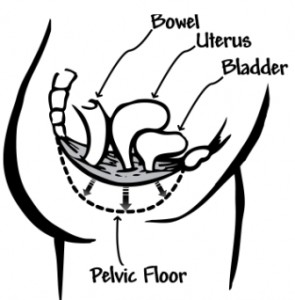 Prolapse and exercise-related worsening of prolapse can be avoided. How do you choose safe exercises, manage your weight and maintain your fitness if you’ve been diagnosed with a prolapse?
Prolapse and exercise-related worsening of prolapse can be avoided. How do you choose safe exercises, manage your weight and maintain your fitness if you’ve been diagnosed with a prolapse?
These Pelvic Floor Physiotherapist guidelines teach you how to exercise with confidence and protect your prolapse.
Read on now to learn about:
- Prolapse and pelvic floor weakness
- How some exercises can make a prolapse worse
- How to choose safe exercise for prolapse
- Prolapse and exercise for fitness
- Prolapse and exercise for strength
- Prolapse and core abdominal exercise
- Prolapse and exercise classes.
Download this Prolapse and exercise information as a user friendly PDF (below).
Prolapse and exercise is by Pelvic Floor Physiotherapist Michelle Kenway to help women with prolapse stay active and exercise safely. Michelle is the author of Inside Out the internationally acclaimed guide to pelvic floor safe exercise for women.
Prolapse Exercises e-Book
International best selling prolapse exercise guide for women with prolapse and after prolapse surgery.
Prolapse Exercises teaches you how to:
- Exercise safely after prolapse surgery
- Reduce your risk or repeat prolapse
- Avoid unsafe exercises
- Choose pelvic floor safe exercises
- Reduce your risk of prolapse worsening
- Improve prolapse support
- Increase your strength and fitness
- Strengthen your core
- Lose weight
Prolapse and Pelvic Floor Weakness
A pelvic prolapse can occur with any of the pelvic organs including the bladder, urethra (urine tube) uterus and rectum. A prolapse occurs when the pelvic floor supports weaken and stretch allowing the pelvic organs to bulge into the walls of the vagina (vaginal prolapse) or from the rectum (rectal prolapse). The pelvic floor supports include the pelvic floor muscles and the strong pelvic floor tissues that hold the pelvic organs in place.
A prolapse usually occurs in women (and men) who have weakened pelvic floor support. The pelvic floor is commonly weakened and prolapse caused by:
- Inappropriate exercise;
- Pregnancy and childbirth;
- Obesity and overweight;
- Chronic straining with constipation;
- Chronic coughing;
- Menopause and ageing; and
- Previous pelvic surgery.
How can exercise make prolapse worse?
Some forms of exercise can weaken the pelvic floor and worsen a prolapse.
If you have a prolapse you are likely to have weakness in your pelvic floor muscles and supportive tissues. This makes your pelvic floor more prone to injury since it is less resistant to pressure and strain. Exercise places downward pressure on the pelvic floor (shown right) If the pressure is too great for the pelvic floor to withstand, the pelvic floor muscles becomes stretched, weak and floppy and less able to support your already prolapsed organs. This is how prolapse can become mere severe with inappropriate exercise that is not matched to the existing strength of the pelvic floor.
Prolapse and weak pelvic floor supports ⇒ inappropriate exercise causes pelvic floor strain ⇒ progressive stretch and damage to pelvic floor tissues ⇒ progressive weakness of pelvic floor ⇒ decreased prolapse support ⇒ prolapse worsens in severity
How to Choose Safe Prolapse Exercises?
The key questions to ask when choosing exercise with a prolapse are:
- How much downward pressure and/or strain does your chosen exercise place upon your pelvic floor?
- How strong and well functioning is your pelvic floor? How well can your pelvic floor provide support to counteract the associated downward pressure?
These following safe exercise selection principles apply to all forms of pelvic prolapse including;
- Uterine prolapse;
- Bladder prolapse;
- Vaginal wall prolapse (cystocoele/rectocoele); and
- Rectal prolapse.
Prolapse and Exercise for Fitness
High impact fitness exercise involves exercises with both feet off the ground at the same time. The impact of landing forcefully increases the downward pressure on the pelvic floor and prolapse. The pressure of body weight is transferred to the pelvic floor and lower body. This is why prolapse symptoms often feel worse inappropriate fitness exercises such as running and jumping. When repeated over extended duration, high impact exercise can progressively stretch and strain the pelvic floor supports.
High impact exercises that may compromise the pelvic floor: 
- Running;
- Jumping;
- Skipping; and
- Some dance exercises.
Fitness and weight loss/management exercise can be readily modified to protect the pelvic floor and remain highly effective. Low impact exercise is the key to reducing impact on the pelvic floor. Low impact exercise is exercise with at least one foot in contact with the ground at all times.
Low impact exercises that are pelvic floor safe include:
- Walking;
- Cross trainer;
- Road cycle;
- Spinning or indoor cycle classes(stay seated and chose low gears);
- Water based exercise;
- Low impact fitball classes; and
- Low impact fitness classes.
Prolapse and Exercise for Strength and Bone Health
Safe strength training with a prolapse is very feasible, however traditional strength training programs are designed for men and often fail to apply pelvic floor safe strength training principles
Pelvic floor and prolapse worsening is more likely with:
- Heavy lifting and straining;
- Specific strength training exercises; and
- Unsupported positions when lifting (i.e. standing).
Strength exercises that increase pressure on prolapse:
- Wide leg deep squats;
- Smith machine squats;
- Leg press (seated and incline); and
- Weighted abdominal core strength exercises.
Women seeking pelvic floor safe strength exercises can access a complete physical workout in Inside Out Strength DVD workout for women with prolapse, designed and presented by Pelvic Floor Physiotherapist Michelle Kenway.
Core Abdominal Exercise and Prolapse
Scientific research shows that traditional intense core abdominal exercises increase the downward pressure on the pelvic floor and cause descent of the pelvic floor in women with pelvic floor dysfunction. The risk of injury seems to be increased with these exercises in women with previous vaginal delivery.
Some unsafe core exercises with a prolapse include:
- Sit ups / abdominal crunches (shown right);
- Fit ball sit ups and medicine ball sit ups;
- The Hundred (Pilates);
- The Plank;
- Fit ball or Swiss ball sit ups; and
- Abdominal exercise machines.
Prolapse and Exercise Classes
Some general exercise classes include exercises that may increase the risk of prolapse worsening with increased pelvic floor pressure. General exercise classes are designed for mainstream, not for women with pelvic floor prolapse. This means that exercises general exercise classes may be unsuitable for prolapse and require modification. The temptation in general exercise classes is often to perform intense and unsuitable exercises with the potential to worsen a prolapse.
Tips for exercise classes and prolapse:
- High impact exercise classes – many of these exercises can be modified to be low impact.
- Strength training/resistance classes can include inappropriate strength exercises and techniques. These can often be modified or alternative pelvic floor safe strength exercises performed.
- Core training classes-intense core exercises will increase the likelihood of pelvic floor and prolapse strain. Core exercises can also be modified using techniques to reduce the intensity of the exercises on the upper abdominal muscles in particular.
If unsure about any exercise either leave it out or speak with your instructor for alternative exercises. Be mindful of the difficulty of catering to a large number of individuals with wide ranging abilities and expectations with pelvic floor safe exercises in group exercise.


 Prolapse and exercise-related worsening of prolapse can be avoided. How do you choose safe exercises, manage your weight and maintain your fitness if you’ve been diagnosed with a prolapse?
Prolapse and exercise-related worsening of prolapse can be avoided. How do you choose safe exercises, manage your weight and maintain your fitness if you’ve been diagnosed with a prolapse?





